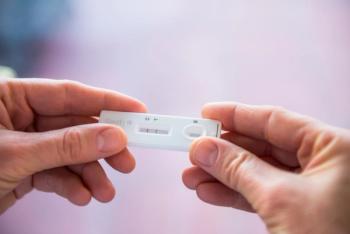
- Vol 36 No 6
- Volume 36
- Issue 6
Fuzzy brown spots on a healthy 3-year-old
A healthy 3-year-old girl presents for evaluation of light brown spots on her trunk and extremities that have appeared over the last 2 years. The spots are not symptomatic but the girl’s parents are worried that she could have neurofibromatosis.
The case
A healthy 3-year-old girl presents for evaluation of light brown spots on her trunk and extremities that have appeared over the last 2 years. The spots are not symptomatic but the girl’s parents are worried that she could have neurofibromatosis.
Diagnosis: Urticaria pigmentosa
Discussion
First described in 1869 by Nettleship and Tay, mastocytosis is a pathogenic expansion of mast cells.1 It is considered a clonal disease attributed to activation mutations found in the C-Kit gene, which leads to increased survival and proliferation of mast cells.2 Disease can be limited to the skin, or it can involve other organs such as the bone marrow, gastrointestinal tract, liver, or spleen.3 In children, 9 of 10 cases are cutaneous, the majority of which are urticaria pigmentosa (UP), also called maculopapular mastocytosis.1
In a systematic review of 1747 cases by Méni and colleagues, 90% of cases presented by the age of 2 years, and almost 70% of cases at least partially regressed.2 Urticaria pigmentosa is more common in boys, although the sex-ratio data inverts in adulthood.
In the Figure, note the lesion on the top-right side of the patient’s back. It urticated when rubbed while the area to the left with normal skin did not.
Clinical findings
The characteristic lesions in UP are scattered small (1-cm to 2-cm), red-brown or yellow-tan thin papules or plaques that develop a wheal and erythema upon physical manipulation (Darier sign). These lesions also can have increased skin markings. Most patients will lack systemic symptoms such as flushing, gastrointestinal (GI) symptoms, bone pain, syncope, or bronchospasm. If the exam is equivocal, biopsy can be done and will show increased mast cell numbers or activating KIT mutations.1
Differential diagnosis
It is essential to distinguish these lesions from cafe-au-lait macules (CALM), which can be associated with a diagnosis of neurofibromatosis type 1 (NF1). The borders of UP lesions are ill defined compared with the well-demarcated borders of CALM. Also, CALM will not urticate. Severe cases of UP can blister and can be mistaken for bullous dermatoses such as epidermolysis bullosa and linear immunoglobulin (Ig) A bullous dermatosis. Lastly, these lesions can be confused with arthropod bites or juvenile xanthogranulomas.4
Management
Because these lesions will likely resolve without sequelae, patients can be monitored annually at their well-child visits, and no treatment is required. Symptomatic therapy with topical corticosteroids and oral antihistamines can be offered to combat pruritus.5 Although systemic involvement is rare in children, it can be evaluated and ruled out with a complete blood count with differential, liver function tests, and a serum total tryptase.6 Patients with systemic symptoms can be managed with oral antihistamines, antileukotriene drugs, and omalizumab.7
Patient outcome
Clinicians reassured the patient and her mother that the spots were benign mastocytomas rather than café-au-lait macules and that they did not have to worry about neurofibromatosis. The mother was counseled about the benign nature of the spots and told that there was no treatment or further evaluation needed for her daughter unless anything changed.
References:
1. Matito A, Azaña JM, Torrelo A, Alvarez-Twose I. Cutaneous mastocytosis in adults and children: new classification and prognostic factors. Immunol Allergy Clin North Am. 2018;38(3):351-363.
2. Méni C, Bruneau J, Georgin-Lavialle S, et al. Paediatric mastocytosis: a systematic review of 1747 cases. Br J Dermatol. 2015;172(3):642-651.
3. Vardiman JW. The World Health Organization (WHO) classification of tumors of the hematopoietic and lymphoid tissues: an overview with emphasis on the myeloid neoplasms. Chem Biol Interact. 2010;184(1-2):16-20.
4. Bolognia J, Schaffer JV, Duncan KO, Ko CJ. Dermatology essentials. Oxford: Saunders/Elsevier; 2014.
5. Heide R, Beishuizen A, De Groot H, et al; Dutch National Mastocytosis Work Group. Mastocytosis in children: a protocol for management. Pediatr Dermatol. 2008;25(4):493-500.
6. Carter MC, Clayton ST, Komarow HD, et al. Assessment of clinical findings, tryptase levels, and bone marrow histopathology in the management of pediatric mastocytosis. J Allergy Clin Immunol. 2015;136(6):1673-1679.
7. Castells M, Metcalfe DD, Escribano L. Diagnosis and treatment of cutaneous mastocytosis in children: practical recommendations. Am J Clin Dermatol. 2011;12(4):259-270.
Articles in this issue
over 6 years ago
Older fathers linked to problems with pregnancies, birthsover 6 years ago
Early paternal bonds impact offspring’s cardiovascular healthover 6 years ago
Paternal involvement boosts infants’ neurodevelopmentover 6 years ago
Fathers’ obesity might impact offspring’s healthover 6 years ago
Fathers’ epigenome affects reproductive healthover 6 years ago
Urine drug screens: Caveats for interpreting resultsover 6 years ago
Developmental screening via phone increases referralsover 6 years ago
Recognize & Refer: Turner syndromeover 6 years ago
Riddle me this: The making of a bullyover 6 years ago
How to identify and treat bullyingNewsletter
Access practical, evidence-based guidance to support better care for our youngest patients. Join our email list for the latest clinical updates.














